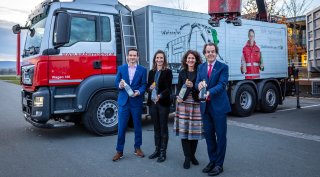
AI makes used glass collection points sustainably clean
Artificial Intelligence optimises route planning. In Styria, Saubermacher employs five HGV drivers to empty used glass collection containers across 90 local authorities. The drivers visit around 1400 collection points in all, emptying some 1900 containers.
In Austria, used glass has been collected separately and recycled for more than 45 years. Saubermacher was a key player in establishing separated collection in Styria, a pioneering role that is being replicated again today in Waste Intelligence, designed to further improve collection and recycling. Saubermacher has been working with cooperation partners Denovo, SLOC and Know-Center to develop an AI-supported system for the further development of waste collection rounds and to facilitate use of digital tools and Artificial Intelligence (AI) in used glass collection. The tool consists of a portal, a special optimisation algorithm and a user-friendly app for HGV drivers. An intelligent platform bundles relevant logistics information (e.g. max. truck payload, traffic data, etc.) with current fill level data, while the special algorithm determines the optimal emptying route. This information together has helped to reduce the number of miles covered on emptying rounds by 15 per cent. The goal of the digitisation measures is to create improvements for residents and to gradually transition to climate-friendly waste logistics.
Eva Koller, managing director of Austria Glas Recycling, has absolute confidence in this innovative new development: “The Smart Collection Platform combines human experience with artificial data intelligence to create a wealth of knowledge of a completely new dimension, which we can capitalise on to improve Styria’s glass recycling system. The ideal configuration of an optimal glass collection system is in the eye of the beholder, and residents have differing requirements to disposal firms, environmentalists or economists. Taking ecological, economic and other aspects into account and carefully balancing them is something that has become quite matter of course for us. Digital elements support us in finding that balance.”

Further development increases cost efficiency. When the project began in 2019, sensors were used to measure fill levels so that data could be collected and analysed to identify optimal routes. The Smart Collection Platform now also works without sensors. With modern-day developments, AI combined with information from HGV drivers can be used to accurately predict the current fill level at each collection point. This pioneering innovation lowers investment costs to almost nil but significantly increases the efficiency of collection routes and reduces overfilling at collection points by as much as 75 per cent. Well-filled collection containers are collected promptly, thereby improving the quality of used glass disposal for residents.
The platform also gives customers transparency for the very first time. With this, we can work with waste management associations to determine optimal locations for collection points based on facts and adapt them to requirements on the ground, such as in the event of overfilling. Associations, local authorities and customers have real-time access to scheduled and driven routes so that they can respond promptly to queries from residents.
“With digitisation and the use of AI, the Smart Collection Platform is creating significant improvements for Styria’s residents. Overfilled collection islands are now a thing of the past and needs-based emptying is becoming a reality in urban areas. I am extremely grateful to Austria Glas Recycling and the Graz region waste management association for the trust they have shown in realising this project together. This is how we actively practise climate protection in the region,” explains Hans Roth, founder of Saubermacher, filled with enthusiasm for the environmentally responsible solution.
New container technology on the rise. In Austria, we are gradually making the switch from pourable containers, where the used glass containers are traditionally tipped into the HGV, to lifting containers, which are lifted over the HGV by crane and emptied. These containers have the benefit of a larger volume than pourable containers and can be emptied by a single person using a crane. This means that fewer personnel are required, along with fewer collection points and containers. As a result, the number of miles travelled on collection rounds is less. The quality of the used glass is also improving as the new containers have better colour marking. This is particularly important because just a single coloured bottle is enough to discolour 500 kilograms of colourless glass. Correct separation of colourless and coloured glass is essential to ensuring that the quality is right for recycling. In addition, glass packaging can be reprocessed an infinite number of times. Working with the Graz region waste management association, the first collection points have already been successfully converted. “The collected used glass is used in the glass plants to produce new glass packaging. Used glass is a valuable raw material, so it’s extremely important that residents continue to drop off their used glass at the containers, even if they are now a little farther away,” explain Christiana Meßner and Heidi Weinhandl, waste consultants at the Graz region waste management association. Across Styria, more than 85 per cent of used glass containers have already been converted to the new lifting system.
press release
Contact
For press inquiries please contact:



